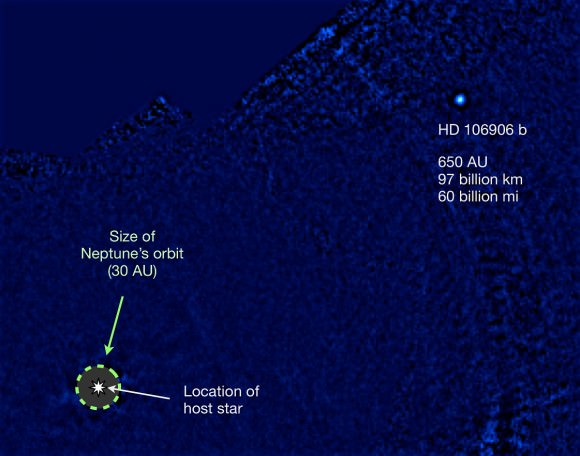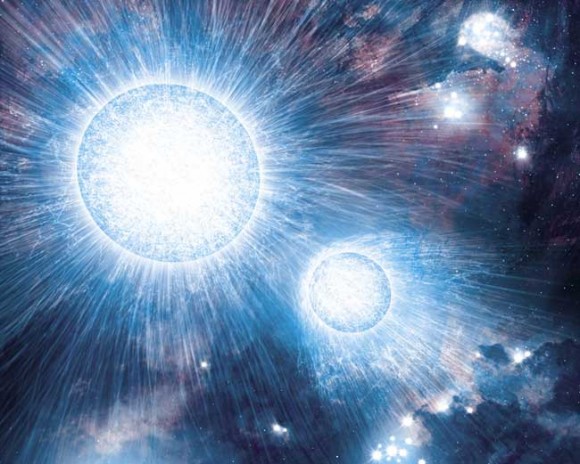What the heck is that giant exoplanet doing so far away from its star? Astronomers are still trying to figure out the curious case of HD 106906 b, a newly found gas giant that orbits at an astounding 650 astronomical units or Earth-sun distances from its host star. For comparison, that’s more than 20 times farther from its star than Neptune is from the sun.
“This system is especially fascinating because no model of either planet or star formation fully explains what we see,” stated Vanessa Bailey, a graduate astronomy student at the University of Arizona who led the research.
HD 106906 b is 11 times the size of Jupiter, throwing conventional planetary formation theory for a loop. Astronomers believe that planets gradually form from clumps of gas and dust that circle around young stars, but that process would take too long for this exoplanet to form — the system is just 13 million years old. (Our own planetary system is about 4.5 billion years old, by comparison.)

Another theory is that if the disc collapses quickly, perhaps it could spawn a huge planet — but it’s improbable that there is enough mass in the system for that to happen. Perhaps, the team says, this system is like a “mini binary star system”, with HD 106906 b being more or less a failed star of some sort. Yet there is at least one problem with that theory as well; the mass ratio of the planet and star is something like 1 to 100, and usually these scenarios occur in ratios of 1 to 10 or less.
“A binary star system can be formed when two adjacent clumps of gas collapse more or less independently to form stars, and these stars are close enough to each other to exert a mutual gravitation attraction and bind them together in an orbit,” Bailey stated.
“It is possible that in the case of the HD 106906 system the star and planet collapsed independently from clumps of gas, but for some reason the planet’s progenitor clump was starved for material and never grew large enough to ignite and become a star.”

Besides puzzling out how HD 106906 b came to be, astronomers are also interested in the system because they can clearly see leftovers or a debris disk from the system’s formation. By studying this system further, astronomers hope to figure out more about how young planets evolve.
At 2,700 degrees Fahrenheit (1,500 degrees Celsius), the planet is most easily visible in infrared. The heat is from when the planet was first coalescing, astronomers said.
The astronomers spotted the planet using the Magellan telescope at the European Southern Observatory’s Atacama Desert in Chile. It was visible in both the Magellan Adaptive Optics (MagAO) system and Clio2 thermal infrared camera on the telescope. The planet was confirmed using Hubble Space Telescope images from eight years ago, as well as the FIRE spectrograph on Magellan that revealed more about the planet’s “nature and composition”, a press release stated.
The research paper is now available on the prepublishing site Arxiv and will be published in a future issue of Astrophysical Journal Letters.
Source: University of Arizona


I have to say the quality of writing is getting very good! Reference to the papers is a great thing.
Could it be a rogue planet that was caught by the gravity of the star?
Considering the amount of heat coming off of the planet, that’s extremely unlikely. If it were a rogue, it would have cooled off from formation before it ever got captured. Here we can see temps indicative of early formation.
Perhaps it wasn’t rogue very long. Or maybe a near-rogue, just teetering on the line of breaking free from the formation of the system, and then thought -‘nah stuff this for a lark, too much effort’.
Or got dragged back in.
I agree, rogue planet seems to be the most likely case. Can’t believe astronomers who make a profession on the study of space failed to think of that possibility.
Here’s a hint for how to be successful in life: stop pretending to know more than the people who make this their career. Those people didn’t spend 6+ years of their life earning their degrees for some random internet person to come by and present his own hypotheses as immediate fact. Watch yourself.
no offense,but there are alot of smart people who can figure this out better than someone with a so called degree…
Yes there are… but I doubt those scientists have just a “so called degree”
Assessing likelyhood without performing an actual analysis seems assinine to me…
Besides, likelyhood does not imply what the actual case is, something proffesionals learn.
On the Origin of Planets at Very Wide Orbits from the Recapture of Free Floating Planets
http://arxiv.org/abs/1202.2362
The planet may have been caught in the star’s debris field and was then bombarded by said debris, causing the planet to slow enough to form an orbit. I wouldn’t be surprised if we found out the planet was on the very edge of the Star’s influence. The planet was probably from a nearby system that recently went supernova, probably 5-8mil years ago. The loss of gravity would’ve sent the planet at a constant speed straight into the path of this new system.
If the planet was an escapee from a nearby system, it would not be bound to this particular system and would continue on its way alone. Orbital capture requires a 3rd object interacting.
The third object you mention is the debris orbiting the star. The closer that planet comes to the star, the more matter it encounters and collects. Eventually, the mass would increase the Gravitational attraction between the planet and the star enough to hold the planet in order. There may also have been celestial bodies involved, such as a stray comet or asteroid.
The debris must both be of comparable mass to the planet, and interact directly with the planet (most likely ejected from the system) in order for the planet to become gravitationally bound.
I am sorry, but I dont see this as a probable conjecture. The planet is too massive, and too far away from the star, and with a lack of supporting evidence in favor of capture. Not ruled out, just not probable. Be aware that 1 Jupiter mass of debris being ejected could fail at gravitationally capturing this planet.
If indeed the planet is orbiting ofc, if it is a rogue nearby planet then ofc it might simply be on its way elsewhere. But then it still seems to young, with somewhat to little movement. I would say this is mostly inconclusive.
Well if it is a rogue planet, how do you explain the heat? Rogue, being a planet swung out of it host system, must have traversed “cold dead space”…
what about a rogue “failed binary star”? I never see someone offer this as an explanation… they talk about rogue planets, but what about a failed star in a binary system that got swung out of that system into this one (a rogue star?)
The universe never fails to surprise us.
My guess would be a small brown dwarf that got caught up by the star.
Isn’t 12 X Jupiter mass about where the planet/star boundary is usually at when we find something that isn’t bound to another star?
#GallifreyFallsNoMore
That’s no moon. It’s a space station!
It’ll be interesting to see what further observations show us. I’d be interested to learn of the eccentricity of HD 106906 b’s orbit and if there any other large bodies in the system. It would also be interesting to watch HD 106906 b carefully to see if there’s anything large orbiting it.
Alternative Gas Planet Formation Mechanism:
The distance of the gas giant merely represents the angular momentum of the system; however, neither core accretion or disk instability will accommodate this distance for an isolated planet, and the planet/star size ratio is prohibitively small for direct wide-binary formation by gravitational instability within the bok globule.
So we may be seeing the degenerate end product of a more complex solar system that created this outcome.
The large amount of angular momentum in this system would typically spawn a binary star system in which excess angular momentum would have caused the collapsing bok globule to fragment into a close-binary protostar.
But even after fragmenting, contracting binary protostars must rid themselves of additional excess angular momentum in order to enter the main sequence. The excess angular momentum may take the form of a ‘bar-mode instability’, displacing the angular momentum outward while allowing the center to continue contracting until the central temperature reaches about 2000 K. At about 2000 K, molecular hydrogen disassociates in an endothermic process that absorbs energy promoting rapid gravitational collapse, forming a stellar core.
The formation of a core isolates the two bar-mode arms which may be of sufficient size and density to be gravitationally bound within their own Roche spheres, forming proto-planets. Similar to protostars, proto-planets typically fragment (bifurcate) due to excess angular momentum, forming binary planets with sufficient energy and angular momentum in their binary orbits to spiral out from their progenitor stars; however, hot Jupiters and hot Neptunes may be bar-mode planets that failed to bifurcate and spiral outward.
Then orbital resonances between binary planets and their progenitor binary stars may greatly accelerate ‘core-collapse’ perturbation, causing binary planets and binary stars to spiral out from their solar-system barycenter as their binary components spiral in, conserving energy and angular momentum.
If binary stars reach the main sequence prior to spiraling in and merging, they may undergo a violent luminous red novae (LRNe); however, most binary close-binary stars with large gas-giant planets may spiral in and merge prior to reaching the main sequence, resulting in far-less violent outbursts.
If both binary stellar components go through bar-mode instability, they typically form 4 gas-giant planets, like Uranus-Neptune and Jupiter-Saturn, in which Jupiter and Saturn formed from the larger (A star) former binary solar component and Uranus and Neptune from the smaller (B star) former binary solar component. Our former binary Sun apparently merged in an LRN at 4,567 Ma, forming the short-lived radionuclides by f-process nucleosynthesis and forming stable isotopes with alpha-process nucleosynthesis, enriching the Sun and comets formed from LRN debris with 12C, 16O, 20Ne, 24Mg, 28Si, 32S, 36Ar, 40Ca, 44Ti, 48Cr, 52Fe, 56Ni and 60Zn.
In the case of hypothesized former binary HD 106906, up to 4 proto-planets may have formed, but if the proto-planets and binary protostar orbited in very nearly the same plane, the other proto-planets may not have survived, having collided with the other binary stellar component (their uncle) as they spiraled out from their progenitor (father) stellar component, and/or one or more proto-planets may have collided with one another and merged in their pithy proto-planet phase.
Core-collapse perturbation may be particularly efficient between binary pairs with high mass differential like the more than 100:1 mass difference between the hypothesized former binary HD 106906 and the hypothesized (former?) binary planet HD 106906b. Since HD 106906 is a solitary star, its hypothesized binary components have merged; however, HD 106906b may still be a binary planet which which we are not yet able to resolve.
Could this have anything to do with the “halo of oligarchs” theory? It’s the only extant theory I can think of that resembles this at all. However, “oligarchs” are supposed to be even farther away from their parent stars, if I remember correctly.
I’m trying to understand this.
if it is so far from the star, how do they know is is not free floating and not orbiting anything? that ‘orbit; is so huge how can they determine this since it would take hundreds of years to make a single transit around once